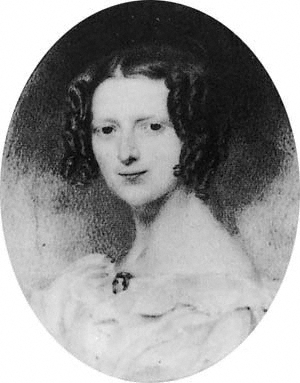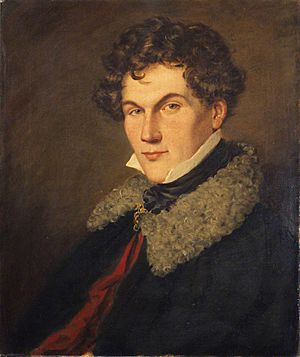Honoria Lawrence facts for kids
Quick facts for kids
Honoria Lawrence
|
|
|---|---|
 |
|
| Born | 25 December 1808 Carndonagh |
| Died | 15 January 1854 Mount Abu |
| Occupation | Writer |
| Spouse(s) | Henry Lawrence |
| Children | 4 |
Honoria Marshall Lawrence, also known as Lady Lawrence, was an Irish writer. She was born on December 25, 1808, and passed away on January 15, 1854. Her writings offer a special look into the daily life of a European woman living in India during the early 1800s. She was also the first European woman known to live in some parts of the Indian subcontinent, like Kashmir and Nepal.
Contents
Her Life and Adventures
Honoria Marshall was born in Carndonagh, County Donegal, Ireland. She was one of fifteen children. She was raised by her uncle, Rear Admiral William Heath.
Meeting Henry Lawrence
In 1827, Honoria met her future husband, Henry Montgomery Lawrence. He was her second cousin and a junior officer serving in India. They spent two exciting weeks exploring London together. Henry wanted to propose, but his low income stopped him at the time.
They wrote letters to each other for almost ten years. Finally, Henry, who was now a captain, proposed to her by letter. In April 1837, Honoria sailed to Calcutta (now Kolkata) in India.
Life in India
Honoria arrived in Calcutta in July 1837. Captain Lawrence was still traveling from the interior of the country. He was busy surveying land in the Gorakhpur and Allahabad areas. They finally reunited and got married on August 21, 1837. From then on, Honoria was almost always by his side. She was a "lady in camp," helping him with his work.
Henry Lawrence's assistant, Saunders Abbott, described Honoria helping her husband. She was in the jungle of the Himalayan foothills. Tigers and wild elephants were nearby. Yet, Honoria was calmly writing letters. She would also read books for Henry or take notes for his writing. She loved sharing in his adventures.
When Henry's work allowed for a more settled life, Honoria continued to help him. In Ferozepore, where he was a civil administrator, she even helped run the post office.
Living in Nepal
In late 1843, Henry Lawrence became the British Resident in Nepal. At first, women were not allowed in Katmandu. But Henry got special permission. In 1844, Honoria became the first European woman to live in Nepal.
She was very happy with the stable life there. She was also amazed by Nepal itself. She wrote that it was "unlike anything I ever saw." She felt it was "more like an artificial model than any actual scenery." They lived in Nepal for almost two years.
The Punjab and a New School
Their next home was the Punjab region. Henry Lawrence became the Resident in Lahore. This meant he had a lot of political power. Honoria was again by his side.
One important thing she did was help start The Lawrence School, Sanawar in 1847. This school was for the children of soldiers. In 1848, Honoria and Henry returned to the British Isles. Henry was knighted, which meant he became "Sir Henry." Honoria then became "Lady Lawrence." She wrote, "I always liked India and now I like it better than ever."
In 1853, Sir Henry disagreed with some political decisions. He resigned from his position. He then became the Governor-General's agent in Rajputana. Honoria Lawrence passed away in Rajputana, at Mount Abu, on January 16, 1854.
Her Writings
Honoria Lawrence was a very active writer throughout her life. She kept many journals and wrote countless letters. In the 1830s, she even started writing a novel, though it was never finished.
Working with Henry
Honoria and Henry Lawrence often worked together on their writings. Honoria managed much of her husband's letters. She also edited or helped write his many articles. These articles were about military and political topics. They appeared in newspapers like the Delhi Gazette and Calcutta Review.
Honoria also wrote her own articles. She wrote about topics like marriage and motherhood. These were published in the Calcutta Review and the Friend of India. She also helped her husband write his novel, Some Passages in the Life of an Adventurer in the Punjaub. This story was published in parts in the Delhi Gazette.
Personal Writings
Honoria also wrote poetry. These poems were shared privately. They were about personal topics, like her marriage. She also wrote about the sad death of her brother. He was killed during the retreat from the Battle of Kabul in 1842.
One of her journals has a short "dramatic sketch." This was a funny play-like piece. It made fun of two British officers whose behavior she did not like.
Her journals were later published in 1980. They were put together by John Lawrence, one of her descendants, and Audrey Woodiwiss. The book is called The Journals of Honoria Lawrence: India Observed, 1837–1854.
Her Family
Honoria and Henry Lawrence were married for sixteen years. They had two sons and two daughters. Honoria also had one miscarriage. Her death may have been due to health problems from a pregnancy later in her life.
Their children were:
- Honoria Letitia Lawrence (died December 18, 1923), who married Henry George Hart. He was a schoolmaster at the Sedbergh School.
- Sir Alexander Hutchinson Lawrence, 1st Baronet (1838 – August 27, 1864)
- Letitia Catherine Lawrence (November 10, 1840 – August 1, 1841)
- Sir Henry Waldemar Lawrence, 3rd Baronet (January 24, 1845 – June 3, 1908)


